Mugello - Medici Villas and Ceramic Manufactories
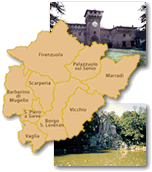
Located a few kilometres from Florence, the Mugello regions offers a rich variety of attractions, thanks to its luxuriant natural environment, its old crafts traditions, and the presence of numerous tokens of a historical-artistic nature. Ruled by important noble families like the Guidi and the Ubaldini since the Middle Ages, the region then attracted the attention of the Medici who, natives of the place, invested great resources there.
Leaving Florence on Via Bolognese and travelling for 15 km, you come to the splendid park of Villa Demidoff in Pratolino which assumes special interest from the viewpoint of science, both for the historical matters tied to its planning and for the wealth of its woodland and faunistic patrimony.
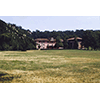
The story of the park at Pratolino began in 1568 when Francesco I de’ Medici, Grand Duke of Tuscany, appointed architect Bernardo Buontalenti to design a villa and a large adjoining park. A few years earlier, Francesco’s father Cosimo I had been assisted by Tribolo for his gardens in Florence (Castello in 1540, the Herb Garden in 1545, and Boboli in 1550). The Pratolino project therefore began almost twenty years after that of Boboli (the park was practically completed in 1585), and Buontalenti laid it out to be a fantasy land where nature and technology blended to create a symbolic journey that would introduce the visitor to the Grand Duke’s philosophical thought. The park aroused great interest among contemporaries straightaway, and for the peculiarity of its artificial grottoes, water tricks and statues was immediately defined as "the garden of wonders". After the death of Francesco, the park met with changing fortunes. The Lorraines were totally disinterested in it and transferred many of its statues to Boboli Garden. It was only after the Napoleonic period, with the return of Ferdinand III of Lorraine, that the park reacquired new dignity. In 1818, Joseph Frietsch was appointed to redo Pratolino. He enlarged it (from about twenty hectares, it grew to roughly 80 hectares), and moreover gave it a completely new look, in line with the taste for the "English garden".
The Medici garden is today a public park, which conserves several basins, statues grottoes and, in particular, the splendid statue of the Colossus of the Apennines (1579-1580) by Giambologna. There are lawns and woods of tall oaks and cedars, and spectacularly large plane trees.
The Medici villa, today lost, on the ground floor had a complex of artificial grottoes with water tricks and automatons. The school for pages of the Medici complex, restored several times in the second half of the 18th century, was transformed into a villa by the Demidoff family in 1872.
This place is tied to events in the life of Galileo: on August 15, 1605, Galileo was sent to Pratolino to present to the Court his geometric and military compass, capable of performing numerous geometric and arithmetic operations, exploiting the proportionality between homologous sides of two similar triangles.
(Paolo Grossoni)
A few kilometres past Pratolino and Vaglia, you come to a roundabout: proceed towards the locality of Ischieti where, after a couple of kilometres, you come to the Medici Villa Trebbio, whose splendid example of hortus conclusus was depicted in the late 16th century in the famous oil lunettes of the Medici Villas by Justus Utens.
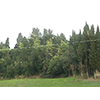
The old castle built on the remains of an ancient Lombard tower, rises on a hill that dominates the Mugello territory. It was transformed into a country residence in 1461 by Michelozzo under commission to Cosimo the Elder de’ Medici. It was also the centre of vast landholdings and therefore had an important farming function. It preserves a precious specimen of hortus conclusus, characterised by extensive terracing and a beautiful arbour that rests on 46 brick pilasters. The inner courtyard has an old well. The villa has hosted illustrious personages like the famous navigator Amerigo Vespucci who sojourned here during the Florence plague of 1476.
(Graziano Magrini)
Backtracking towards the roundabout and taking SR65 northbound, before reaching Barberino di Mugello, the visitor is welcomed by a third Medici villa, born as a fortress and remodelled several times. The Cafaggiolo estate is surrounded by a vast park, and was the headquarters of a famous majolica factory, active until the late 16th century.
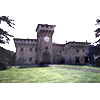
The old castle was transformed into a country residence in 1451 by Michelozzo on commission to Cosimo the Elder. The new and sumptuous villa, surrounded by gardens and a vast park for hunting, it became the favourite summer residence of the Medicis and their guests. The nineteenth-century transformations, ordered by prince Marcantonio Borghese, largely cancelled the original aspect.
The villa is also connected to the world of technology. Indeed, a manufactory that made the famous majolica was built next to the castle. There were two kilns, one used to make an average quality production, the other for a high quality production. Founded in the late 15th century by potter brothers Pietro and Stefano di Filippo, the majolica manufactory at Cafaggiolo produced authentic masterpieces throughout the 16th century, destined to the grand-ducal family (vases, jugs and cups), as well as to city institutions, such as the Santa Maria Nuova Hospital of Florence.
(Alessandro Tosi)
In more recent years, the great ceramics tradition of Mugello, best represented by the work of the Chini family, can be traced back in its historical evolution, visiting the Museum of Borgo San Lorenzo, which is reached by backtracking towards San Piero a Sieve and taking SS551 to the town.
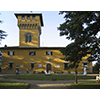
In 1896, Galileo Chini founded a manufactory of artistic ceramics in Florence with the name of "Arte della Ceramica" which, however, due to contrasts between partners, closed in 1905. The following year, a new manufactory opened in Borgo San Lorenzo with the artistic direction of Galileo Chini himself and the technical direction of his cousin Chino Chini. Galileo designed the shapes and decorations, while Chino, using chemical formulas and secret recipes, translated them into concrete products.
The Museum is part of the Mugello - Upper Mugello - Val di Sieve Diffused Museum and is housed in the Villa Pecori Giraldi. It has samples of ceramics, stained glass, drawings, decorations and reconstructions of the production of the "Arte della Ceramica" and of the San Lorenzo Furnaces of the Chini family. An interesting section is dedicated to reconstructing the manufactory’s working phases.
(Graziano Magrini)
****************************
Texts by Elena Fani
English translation by Victor Beard
Last update 26/feb/2008



 = libraries and archives
= libraries and archives  = scientific research centers
= scientific research centers  = memorial places of scientists
= memorial places of scientists = public health places
= public health places = places of science and worship
= places of science and worship = places of technology
= places of technology  = museums and collections
= museums and collections  = villas and gardens of science
= villas and gardens of science

